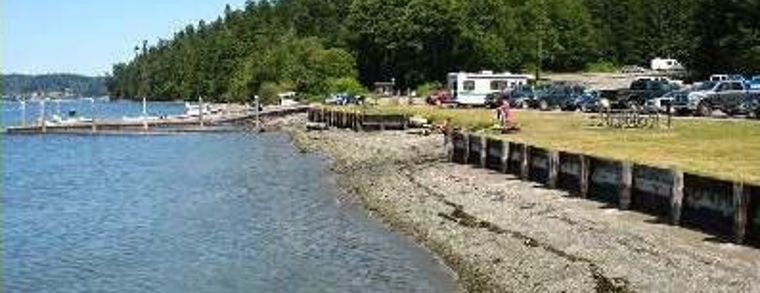Cornet Bay Restoration
At Cornet Bay, on the northern tip of Whidbey Island, we worked with several partners to restore almost 1,000 feet of altered shoreline to a more natural condition. Our partners included the Northwest Straits Foundation, Washington State Parks, Island County, Sound Water Stewards, and Skagit Fisheries Enhancement Group.
Major elements of our project involved removing a creosote bulkhead and the fill material behind it, re-grading the beach to match existing, natural, beach slope at nearby reference sites and replanting the restored shore area with native vegetation. The work is designed to improve spawning habitat for forage fish and nearshore habitat for salmon and forage fish by eliminating a source of beach scouring, expanding intertidal habitat, improving beach composition, removing a source of hydrocarbons leaching from the bulkhead and improving riparian vegetation.
Learn more about the Cornet Bay project on the Northwest Straits Foundation's page.

Before

After
Our work includes ongoing monitoring of how juvenile salmon use Cornet Bay. To learn more about this, please see the studies below. We also monitor the site for forage fish spawning. In August 2017, we documented the presence of surf smelt eggs within the restored area. Read more about our forage fish survey work here.
Our Cornet Bay project was funded initially by a $175,000 grant to the MRC in 2007 from the National Fish and Wildlife Federation (NFWF). We matched this with about $41,000 of MRC funds and in-kind services. By the end of 2010 the total project value had grown to more than $700,000 with these additional resources:
- $45,000 -- Washington State Parks matching resources
- $44,000 -- Northwest Straits Commission
- $50,000 -- Oak Harbor off-site mitigation funding
- $4,675 -- Watershed characterization work
- $75,000 -- NFWF additional funding
- $35,000 -- US Fish & Wildlife Service
- $268,875 -- Salmon Recovery Funding Board
Cornet Bay is a functioning estuary located alongside the narrow, deep channel of Deception Pass, about five miles from the mouths of both the north and south forks of the Skagit River. The Skagit is the largest source of out-migrating juvenile Chinook salmon in Puget Sound and Cornet Bay is about halfway to the open ocean on the shortest path to it from both mouths of the river.
We view Cornet Bay as an important opportunity to showcase successful restoration to the Island County community. The restoration message will reach thousands of visitors annually because Cornet Bay is one of the most heavily-used fishing, boating and picnic areas in the parks system.